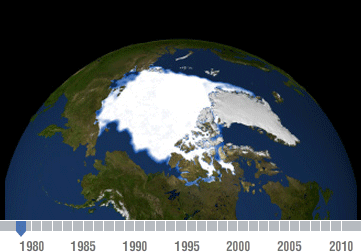

The Great Melt: This animation of images taken over time by NASA satellites shows Arctic sea ice declining for the past 30 years. The year to year rate of decline 11.5 percent per decade. Via The Bridge. Image Credit: NASA/Goddard Scientific Visualization Studio
Global warming is remaking the Arctic, with changes like ice-free sea lanes across the Arctic Ocean in summer, or no-longer-so-eternal permafrost on land, unprecedented in human history.
How much one laments or celebrates these changes probably depends on where one’s values fall across a scale extending from “untouched wilderness” at one end to “lucrative oil field” at the other. But it’s indisputable that they’re creating new opportunities for scientists to learn more about the region than they’ve been able to in the past–and a new sense of urgency.
“The Arctic in the Anthropocene: Emerging Research Questions,” is a report by the National Research Council that tries to identify the questions brought on by the Great Arctic Melt. It was released last month in pre-publication form.
The Arctic is changing so fast, we’re unlikely to have many second chances at fixing mistakes.
I’ve only skimmed the surface of this report so far, but already can tell it has a lot to offer. Stephanie Pfirman, an environmental scientist at Barnard College, Columbia University, who co-chaired the committee that created the report, spoke with me briefly about it as well.
If you haven’t heard the word “Anthropocene” before, it is a recently-coined name for the current period in Earth’s history, when human actions are having a planet-scale impact. Putting the word “Anthropocene” in the report’s title, Pfirman told me, was a way to expand its scope beyond the typical confines of scientific reports about global warming and the Arctic. “Anthropocene is about more than just human influence on the planet,” she said. “It’s also about human interactions, ingenuity, and capacity to solve problems.”
New questions
The sections on the “evolving Arctic” and the “connected Arctic” cover relatively well-identified questions, known unknowns that include: How do and will the new levels of heat in the Far North change weather patterns in other parts of the world? And as the region’s geopolitical importance increases, can Arctic native peoples gain greater political power, and a new degree of self-determination?
More novel are the sections that ask questions about the “hidden Arctic,” as in “what we may find now that we have access to new areas, new technologies,” says Pfirman, “but also what we may lose forever”; the “managed Arctic” of unprecedented expansion in the land and other resources available to human inhabitants of the region; and the “undetermined Arctic” of uneven research funding, spotty monitoring tools, and other barriers that complicate efforts to study and understand the changes.
The Arctic’s own special qualities seem to have propelled the report’s cross-disciplinary framing of the questions. Breaking through old boundaries that have divided disciplines may be more important than ever, because the Arctic is changing so fast, we’re unlikely to have many second chances at fixing mistakes.
“The need for actionable Arctic information has never been greater,” said Pfirman. “Whether or not they have the information, people are making decisions now.”
6/17/14 Update: Don’t have time to read the whole report? Here’s the official video:

